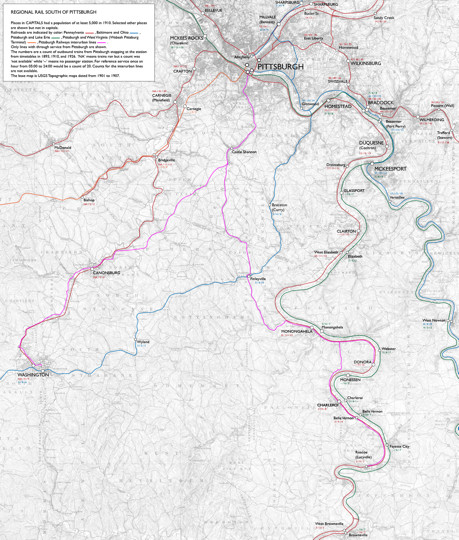
Notes on the Charleroi and Washington Interurbans
Pittsburgh Railways acquired the Pittsburgh and Castle Shannon Railroad as an important step in building two interurban railways deep into the wilds of Washington County. The first one was the so-called Charleroi line, which actually ran even farther, to Roscoe, 26 miles from Pittsburgh as the crow flies and more than 40 by the twisting route any rail lines had to take around the hills. The Washington line, a little shorter, followed only a few years later. Almost all this was built between 1900 and 1910. A remarkable thing is that they both ran intact until the late date of 1953, by which time very few interurbans were left, and that their nearer sections within Allegheny County still run today as the T.
All too many interurbans were built practically alongside steam railroads. It was somewhat inevitable. The populated places had developed where the railroads were, and so that's where the interurbans went, and so did the early two-lane state highways. The interurbans often ran in streets in towns, which slowed them down, but they had an interesting advantage over the steam railroads— frequent service. Travel time can be computed not only by how long the ride is, but also by how long the wait. If the steam train gets you to town in an hour, and the interurban in an hour and twenty minutes, but the steam train runs only a few times a day and the interurban every hour or more often, then how long does it take to get to town starting right now? Most of the time, in that case, the interurban wins.
These two interurbans were unusual in that the first half of each was not parallel to a steam railroad. The reason has to do with the extremely hilly topography that forced railroads to follow the river valleys to get good grades. The coal mines all had short railroads downhill to the rivers to deliver the cargo to the trains and the boats, and the factories were all there, and so the factory towns were all there too. So the railroads all went somewhat to the east or west before running south, around the territory directly south where Pittsburgh Railways had a monopoly on passenger services. But inevitably, to reach population, the Charleroi interurban had to drift east to Monongahela City and follow that river and its railroad, and similarly the Washington interurban drifted west to Canonsburg and followed another railroad down the Chartiers River valley.
I made a map to give a broader view of the situation than the close-up treatment of my three large maps. Click to see it it larger. To give an idea of the steam service, I counted outbound trains to each of the sample stations shown on the map. Without that the map could be very misleading. All those railroads! But many offered only a few trains a day. Although it's a little out of scope, do note the level of service on the Pennsylvania Railroad main line east, which runs through many well-populated towns. Nothing else on the map reached that level, except the interurbans. Sadly I do not have real counts for them except a note on the Charleroi Interurban page about cars running every half hour, which makes about 40 a day.
Some of the "steam" network outlasted the interurbans, but in a vastly reduced form. The once-intensive local Pennsylvania Railroad services east were gradually reduced and ended in 1964. The last local railroad service was on the Baltimore and Ohio route to McKeesport, terminating at Versailles, which was run by PAT as the PATrain from 1975 until it ended in 1989.